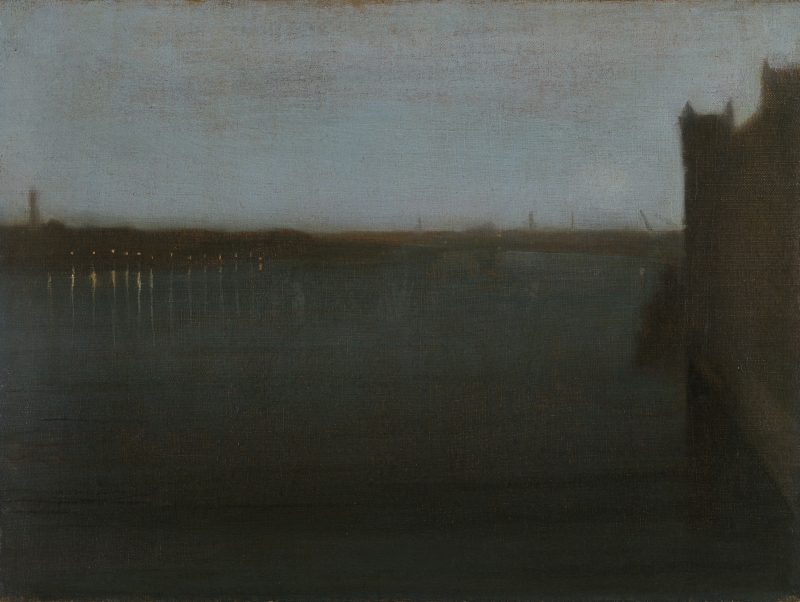Titles
Several possible titles have been suggested:
- 'Nocturne in Blue and Gold, No. 3' (1875, Dudley Gallery). 1
- 'Nocturne - Blue & Gold Wes[tminster]' (ca 1875, Whistler). 2
- 'Nocturne in Blue and Gold' (1877, Grosvenor). 3
- 'Nocturne: from Westminster Bridge' (1892, Whistler). 4
- 'Nocturne. Grey and Gold – Westminster Bridge' (1892, Goupil). 5
- 'Nocturne: Grey and Gold – Westminster Bridge' (1980, YMSM). 6
The title 'Nocturne in Blue and Gold, No. 3' was given to this painting in 1875, and referenced by Whistler later in a sketch of this painting, Souvenir of Nocturne in Blue and Gold / From Westminster bridge [M.0569]. However, 'Nocturne in Blue and Gold, No. 3' is also written on a label on the verso of another painting, which is now known as Nocturne: Blue and Silver - Battersea Reach [YMSM 119].
To avoid confusion, the title used in 1892, Nocturne: Grey and Gold – Westminster Bridge , is generally accepted for the painting under discussion here.
Description
Whistler described it as: 'A very warm summer night on the Thames ... A Nocturne in blue and gold - view of the river from the Houses of Parliament.' 7
Two square towers of the Houses of Parliament are seen on the right. At far left, on the south side of the river Thames, is a factory chimney and then, all along the riverside, dark buildings and a regular series of lights, reflecting in the water. In the distance, on both sides of the river, appear several more chimneys and, at right, a crane.
Site
Whistler described the site as 'on the Thames ... view of the river from the Houses of Parliament.' 8
It is a view of the Thames from Westminster Bridge looking upriver towards Chelsea, London. Two square towers of the Houses of Parliament are seen on the right, on the north bank of the Thames.
In 1859 Whistler had etched Old Westminster Bridge (G.47), a view of Westminster Bridge itself, including Big Ben and the Houses of Parliament. Next came The Last of Old Westminster [YMSM 039], which shows the bridge being demolished but does not show the Houses of Parliament. Much later, in 1896, he included the Parliament buildings in a watercolour, Westminster from the Savoy [M.1471], and a lithograph, Savoy Pigeons c154, which is the view upriver from the Savoy Hotel, with the Parliament buildings and Westminster Bridge in the distance.
At the Whistler v. Ruskin trial in November 1878 Whistler described it merely as 'a scene on the river.' 9 The art dealer Oswald Bernard Colnaghi (1826-1907) was prepared to witness on Whistler's behalf at the Whistler v. Ruskin trial, telling Whistler's lawyer, James Anderson Rose (1819-1890), that it was an 'almost extraordinary and wonderful picture,' and a 'transcript of nature.' 10 However in the end Colnaghi failed to testify.
Notes:
1: Ninth Winter Exhibition of Cabinet Pictures in Oil, Dudley Gallery, London, 1875 (cat. no. 160).
2: Written on a card on the verso, Glasgow Museums.
3: I Summer Exhibition, Grosvenor Gallery, London, 1877 (cat. no. 6).
4: Whistler to D. C. Thomson, 4 January 1892, GUW #08214.
5: Nocturnes, Marines & Chevalet Pieces, Goupil Gallery, London, 1892 (cat. no. 19).
6: YMSM 1980 [more] (cat. no. 145).
7: Whistler to Alfred Chapman, [June 1874/1875], GUW #07901.
8: Whistler to Alfred Chapman, [June 1874/1875], op. cit.
9: Merrill 1992 [more] , p. 146.
10: J. A. Rose, 21 November 1878; Merrill 1992 [more] , pp. 80, 344 n. 27.
Last updated: 22nd May 2021 by Margaret







